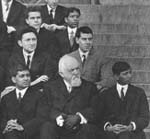NEW, THINKING, AGILE, AND PATRIOTIC
Introduction
 In the early twentieth century, several hundred students from India found their way to the U.S. and enrolled in American universities, primarily on the Pacific coast. Some were drawn by the opportunity of a technical education which was greatly needed in their home country; others, imbued with political fervor, wished to learn more of the nation that had successfully thrown off the British yoke more than a century before. Many, if not most, of these students came from the elite strata of society and initially had little connection with the farmers and laborers who had immigrated to British Columbia and California – and to a lesser extent Washington and Oregon – at about the same time. Between 1908 and 1915, approximately 25 Indian men came to Seattle to study at the University of Washington, one of a dozen or so American institutions favored by student immigrants from Bengal and other Indian regions.
In the early twentieth century, several hundred students from India found their way to the U.S. and enrolled in American universities, primarily on the Pacific coast. Some were drawn by the opportunity of a technical education which was greatly needed in their home country; others, imbued with political fervor, wished to learn more of the nation that had successfully thrown off the British yoke more than a century before. Many, if not most, of these students came from the elite strata of society and initially had little connection with the farmers and laborers who had immigrated to British Columbia and California – and to a lesser extent Washington and Oregon – at about the same time. Between 1908 and 1915, approximately 25 Indian men came to Seattle to study at the University of Washington, one of a dozen or so American institutions favored by student immigrants from Bengal and other Indian regions.
Unfortunately, little is known about this group of “Hindu” students – Hindu being a term that Anglo-Americans then applied indiscriminately to Muslim and Sikh inhabitants of the Indian subcontinent (Hindustan) as well as to Hindus proper.1 Most apparently attended for short periods and are known only by name from sources such as the Tyee (the university annual), the student directory, the Seattle city directory, and graduation programs. They participated in campus organizations such as the Cosmopolitan Club, an international students’ association founded in 1907 with chapters throughout the U.S., as well as more Indian-specific associations such as the Hindustan Club and the Hindoo Students’ Ashram.
Two students who earned bachelor’s degrees at the UW during this period, Taraknath Das and Jogesh Misrow, illustrate the complex interplay of political, economic, and social forces at work in the lives of Indian immigrants of the day. Though it is unlikely that they knew each other prior to immigration, for a time they lived in the same house with three other East Indian students at 4343 9th Ave NE, near the University. Both were employed as interpreters for the U.S. Immigration and Naturalization Service, and both were concerned with the difficult situation facing their countrymen who managed to find work in Canada or the U.S. But where Das advocated the overthrow, by violence if necessary, of British dominion in India, Misrow appears to have been less radical, and after departing the west coast for Chicago in 1915, turned to poetry and essay as means of bridging the cultural ocean separating North America and India.
In April, 1908, the Overland Monthly commended to its readers an article by an Indian student at the University of California, Girindra Mukerji, whom the Monthly’s editor described as representing “the new, thinking, agile and patriotic Indian, who sees in the obliteration of caste and in industrial advancement and education an escape from the thralldom of religion and foreign domination.”2 In the essay which followed, Mukerji described the importance of American higher education for his countrymen, reiterating an argument made by another recent Indian visitor to the U.S., Swami Rama Tirtha, that the vast sum of money spent on missionary work could be “used in inviting Indian youths to the American homes, and to their educational institutions, and would be spent right in their own country with better results.”3
Noting the potential for greater economic ties between India and the U.S. in the future, Mukerji asserts
… there is the prophecy of an immense inter-communication, a great future exchange of commodity and thought, to be found in the development along American lines of the minds of the youth in your colleges. Who shall say, if we give it in exchange, that a leaven of Hindu philosophy would not improve the humanity and even the business instinct of the strenuous American. India looks to America for a certain kind of help – and it will not be denied. It is an appeal from the oldest civilization to the newest.4
A young institution in a young country, the University of Washington heard and responded to this appeal.
1. At the time early immigrants from India arrived in the U.S., “Indians” was the term applied to Native Americans, so “Hindus” or “East Indians” was preferred. When the context is clear, “Indians” will be used in this website to denote immigrants from India; alternatively, the contemporary term “Asian Indians” may be used.
2. The editorial comment prefaced Girindra Mukerji, “The Hindu in America,” Overland Monthly 51, no 4 (April 1908): 303-308.
All segments of "NEW, THINKING, AGILE, AND PATRIOTIC: “Hindu” students at the University of Washington, 1908-1915" are copyrighted by the University of Washington Libraries. "NEW, THINKING, AGILE, AND PATRIOTIC" may be used online. Segments of "NEW, THINKING, AGILE, AND PATRIOTIC" may be downloaded for personal use. The URL may be included in another electronic document. ©2006
Image taken from "The 1911 Tyee of the University of Washington", Volume XI, 1910, p. 197.